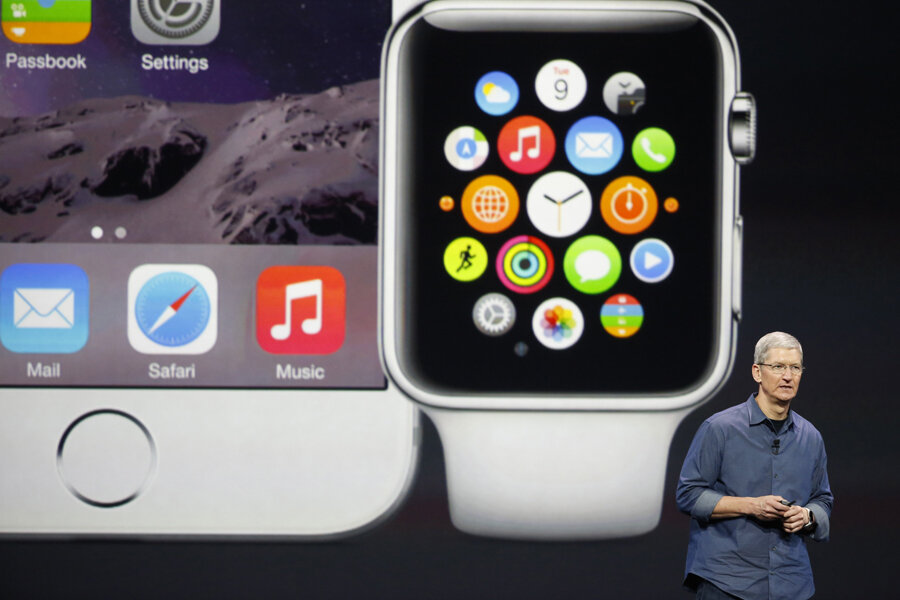Apple unveils iPhone 6 Plus and Apple Watch
Loading...
Tim Cook couldn't help but smile. As he took the stage shortly after Apple unveiled not one, but two new versions of the iPhone, the Apple chief executive said, simply, "We have an entirely new product."
It was the announcement audience members gathered in Cupertino, Calif., had been waiting for. A new device, possibly a smart watch, had been the subject of choice for countless tech bloggers in recent weeks. They wanted something new, something to recapture the "magic" that defined Apple in the years under enigmatic co-founder Steve Jobs. There was the iPod, the iPhone, the iPad – and now?
Apple Watch.
Looks like the blogosphere had it right. A series of images revealing a small, square display with rounded edges fluttered across the screen behind Mr. Cook as he beamed, looking like a proud child sharing his prized possession at show-and-tell.
"Apple Watch is the most personal device we've ever created," he told the crowd, eliciting roaring applause.
The first entirely new product made under Cook, this watch drops the "i" of previous Apple products. It is perhaps symbolic of a small, though not insignificant, break with the company's past, at least in cultural standing. Perhaps the moment Cook stepped out from under the shadow of his famed predecessor, the moment Apple became, fully, his own.
At least, that's what the company seems to hope.
The bigger the phone...
Apple revealed the iPhone 6 and the iPhone 6 Plus. Both have larger screens than previous versions at 4.7-inches and 5.5-inches. The latter meets widespread anticipation that Apple would finally release a larger phone, or "phablet," to compete with a smart phone market already awash in phablets, mainly from Apple-rival Samsung.
Illustrative of the demand for bigger phones, phones measuring 5.5- to 5.7-inches in size will surpass the number of laptops shipped this year and the number of tablets shipped in 2015, according to market research firm IDC.
The new iPhones, which run Apple's latest operating system iOS 8, give users more maneuverability with a one-handed mode and a screen that allows for enhanced horizontal views. The screens have higher resolutions than their predecessors and the phone bodies are thinner.
Set for a Sept. 19 release date, with pre-orders available beginning Sept. 12, prices for the smaller phone will start at $199 while the larger one starts at $299.
Mobile payments
A new iPhone feature called Apple Pay allows for mobile payments. Dismissing the traditional wallet as clunky and outdated, a video showed a woman holding a phone with an image of a Visa credit card up to a sensor as she paid for items. According to Molly Wood of The New York Times, mobile payments, until now, have "gone nowhere" in large part because the technology has been too complicated for average users.
But with near field communication (NFC) technology coming into its own, which lets users pay by just tapping their devices to a scanner, mobile payments have become more efficient and easy to use. With the new iPhones featuring a built-in NFC chip, Apple appears poised to make paying with your phone a lot more common.
Visa, MasterCard, and American Express are working with the new payments service. And users will be able to pay with their phones at a variety of big-name chains, such as Starbucks, Subway, Walgreens, and Macy's.
Coming on the heels of a notable iCloud data breach, Apple has recently come under scrutiny for a large-scale hack that involved leaking scandalous celebrity photos onto the Web. This compels the question: why would customers trust the retailer with valuable credit card information?
Eddy Cue, an Apple senior vice president, tried to assuage concerns of privacy and cybersecurity by noting that Apple will not keep track of what users buy, how much they pay, and where they make purchases. Nor can cashiers see customers' names or credit card information. He added that users have the added security layer of the Touch ID fingerprint sensor.
"We are not in the business of collecting your data," Mr. Cue said.
Users can store their credit cards in Passbook, an iPhone feature that lets users store items such as boarding passes, movie tickets, and coupons in a single place.
Should users lose their iPhone, they can suspend all payments with a service called Find my iPhone.
So, what's with the watch?
Most of the event was reserved for introducing the new watch, which Cook billed as "the next chapter in Apple's story."
While smart watches have already been released from competitors like Samsung, LG, and Pebble, many have been looking to Apple to see if this new sector of consumer electronics can take off in the mainstream. Wearable devices are expected to more than triple in number by the end of this year and revenue from global wearables is predicted to reach $37 billion by 2020.
Although a smart watch, as well as larger phone screens, could be written off as Apple following market trends instead of sticking to its mantra of original innovation, neither the iPod nor the iPhone were the first products of their kind on the market when first released.
Rather, they built on existing devices by developing such features as a sleek touch-screen interface and adding new services like the iTunes music store that gave customers an easy, efficient means to download music from the Web. If consumers react the same way to the watch as they did with previous Apple products, analysts say, Apple could be considered a leader in smart watches as opposed to a follower.
But among the features displayed at Tuesday's event, the product doesn't seem to differ much from what's already available among other smart watches – the ability to field calls from your smart phone, work with apps on your wrist, dictate messages. These features bear similarities to ones on Android Wear, the Google operating system used on numerous smart watches currently available.
The primary difference for Apple's device, it would appear, is aesthetic.
The Watch will come in two sizes and allow for mobile fitness tracking, relying on sensors on the back of the watch that pull data from the wearer's wrist. These sensors can also give users reminders on when to exercise and are in keeping with the theme of popular fitness wearables on the market such as the Fitbit line of devices and the Nike FuelBand.
Users can choose from six different wrist bands and three distinct watch versions, including a stainless steel edition, an athletic version made with anodized aluminum, and a classy version made with 18-carat gold.
Cook emphasized that this is not an iPhone interface shrunken to fit on the wrist. A digital crown on the watch's side serves as the primary tool for controlling the device. Turning the crown lets users zoom in and out on images displayed on the watch's screen such as maps or lists of reminders. Pressing the crown returns users to the watch's home screen, an assortment of bubbles, each representing a different app such as Music, Messages, or Clock.
In addition, although iPhone notifications will be relayed to the watch's screen, Apple says developers can create unique notifications and apps just for the watch.
The device is priced at $349 and, unsurprisingly, will only work with an iPhone; specifically an iPhone 5 or later.
Apple shares rose following the new products' release, but subsequently fell to end the day down. Though Apple has had a strong year, the typical trend for a new Apple product unveiling, analysts note, is for stocks to rise in the weeks leading up to the release, and then decline in the proceeding days.






